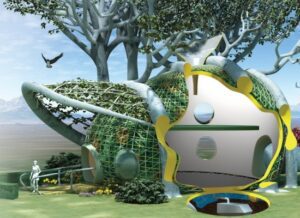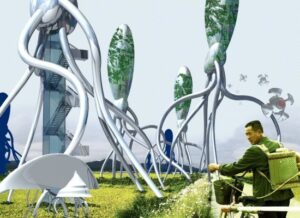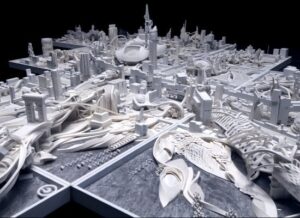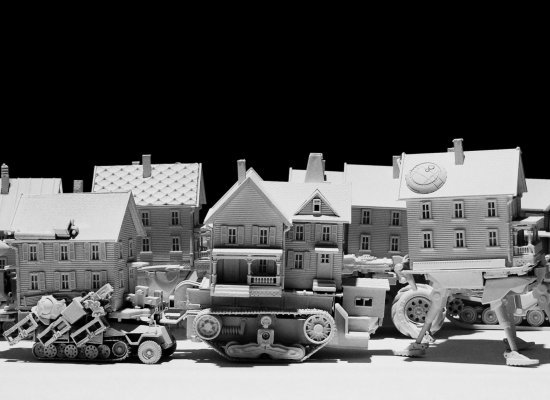Architect and urban designer Mitchell Joachim hates the idea of a lower-pollution New York a hundred years from now. He envisions a city that actually eliminates pollution.

“I want a city that cleans up the impact of the last hundred and fifty years of industrial waste. It has to have a positive impact,” said Joachim, pacing up and down his studio in the Metropolitan Exchange building on Flatbush Avenue in Brooklyn.

The Green Brain Park
At a time when most progressive urban designers try to make cities greener, this co-founder of the nonprofit design group Terreform ONE and his team are on a crusade to radically change the notion of how cities like New York will function in a hundred years. Only completely flipping ideas about housing, transportation, and recreation spaces can city planners project a revolutionary urban habitat, according to Joachim and his crew.

The Future Brooklyn
Houses are mounted on mobile platforms and can move to wherever they need to be, all sustainably powered, of course.

Homeway Houses
Expressing discontent with the current state of urban living, Joachim, a TED fellow and a figure recognized by Wired magazine in 2008 as one of the 15 individuals “the next president should listen to,” advocates for a radical shift from conventional brick structures. Dismissing the prevailing notion of contentment in brick homes, Joachim envisions houses constructed from unconventional materials, including waste. Terreform ONE, a design group led by Joachim, posits that New York City’s daily disposal of 38,000 tons of waste could construct a 54-story skyscraper made from compacted waste.
Joachim and his team have conceptualized the Fab Tree Hab, a dwelling grown from native trees, proposing a community that harmonizes with ecological principles. Despite criticism about the time required to grow a village of such homes, Joachim emphasizes the societal patience spent on other indulgences, contrasting it with the timeline for growing a village.
For those uninterested in living in a home made from trash or grown from trees, Joachim presents an alternative: houses made of meat. These shelters, cultivated in a lab using meat cells, replace traditional building materials with tissues, skin, and bones. Joachim envisions sphincter muscles for windows and doors, creating a novel living experience with unique materials.
Terreform ONE’s futuristic vision for New York City in 2120 extends to transportation, challenging the current paradigm of metal cars. Joachim proposes soft cars that allow for gentle interactions and touches between vehicles, a departure from the current culture of preserving pristine car exteriors.
In this envisioned future, Central Park undergoes a transformation, becoming more than a leisure space. Vertical farms, capable of feeding substantial populations, geothermal wells, and waste adaptors redefine the park as a productive green space designed not only for recreation but also for energy and food production, as well as water collection and filtration, supporting the vision of a self-reliant city according to Terreform ONE co-founder Maria Alolova.

The Sheep Car
Joachim and Alolova ultimately aim to start cities from scratch, coming up with solutions that reduce the gap between science fiction and reality. “Let’s have critical arguments about how we live,” Joachim said. “Don’t swallow the pill that someone else gave you. We can create a better city.”
From POPSCI
ENVIRONMENTAL VISIONARIES: THE URBAN REMODELER
Mitchell Joachim’s visionary concept of ecological supercities, complete with swarms of jetpacks and mass-transit blimps resembling flying jellyfish monsters, might seem like something out of science fiction. However, the distinction lies in the fact that Joachim is actively bringing these ideas to life.
A 39-year-old professor of architecture at New York University, with graduate degrees from MIT, Harvard, and Columbia, Joachim emphasizes that his futuristic proposals are firmly grounded in existing technologies. He envisions jetpacks forming swarms, houses cultivated from living trees, low-altitude blimps resembling 24/7 ski lifts hovering over New York City, and WALL-E-like machines constructing buildings and bridges from recycled waste. These ideas, he asserts, are not mere Hollywood fantasies but practical designs that could be implemented today.
Joachim’s endeavors are channeled through Terreform ONE, a nonprofit design collective he co-founded to explore sustainable and fully integrated urban planning. Their approach involves envisioning how future cities can best serve citizens on a large scale and experimenting with the small-scale materials and designs necessary to bring these visions to life.
Terreform ONE’s annual TerreFarm event brings together architects and scientists to explore innovative urban farming techniques. This summer, they plan to transform a Brooklyn rooftop into a testing ground for modular growing methods, designs optimizing sunlight, and lightweight soil mixes crucial for rooftop gardens. Additionally, they will construct wall sections of Joachim’s Fab Tree Hab, a proposal to create “living” homes by grafting trees together around scaffolds and growing them on-site.
Joachim’s focus on mobility extends to envisioning car-share systems replacing individual cars, designed with soft exteriors and the ability to communicate with the city grid. His blimps, functioning like trolley cars but with the flexibility to traverse geographical features without bridges, would offer unique transportation solutions. The jetpack designs, inspired by modern ducted-fan technology, would be part of a commuting system where individuals are towed in flocks before breaking off to reach their destinations.
In Joachim’s future cityscape, sharp metal boxes are obsolete, replaced by innovative designs prioritizing safety and community well-being. As an architect, he sees his responsibility in contemplating the implications of emerging technologies, such as jetpacks, on the urban landscape of the future.





